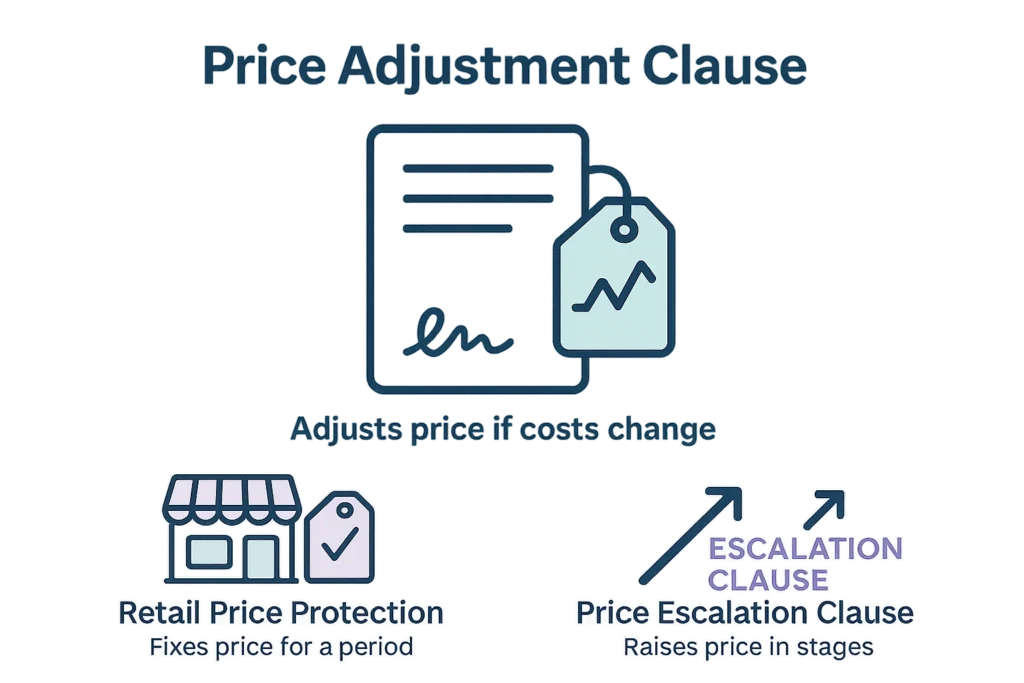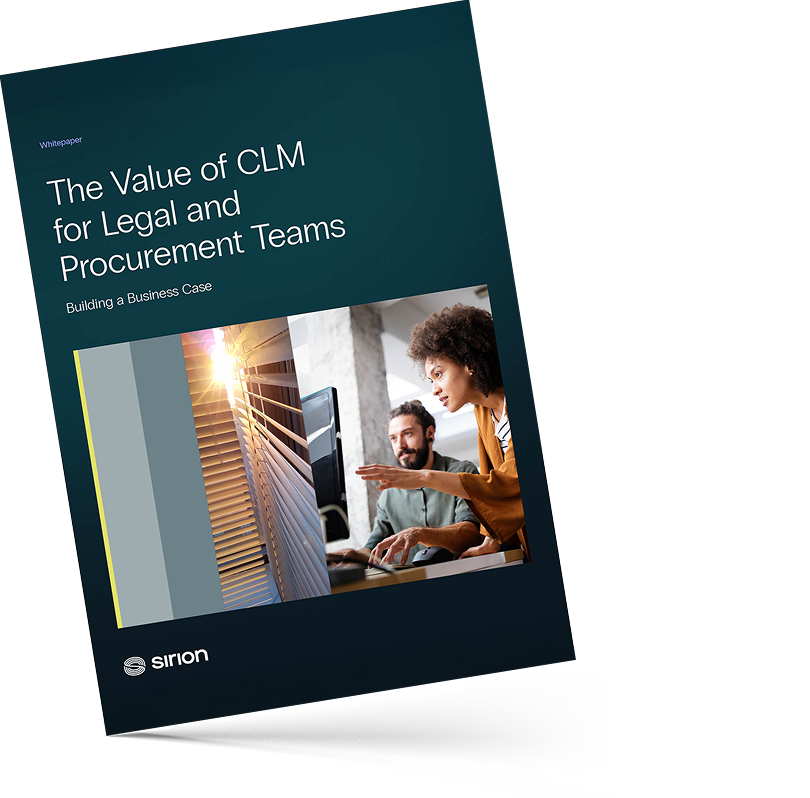Contract Price Adjustment Clauses Explained: How to Manage Risk and Compliance

- Last Updated: Oct 30, 2025
- 15 min read
- Arpita Chakravorty
You signed the deal. It’s a three-year agreement, and the pricing felt solid, locking in your costs and protecting your margins. But six months later, the world looks different. A sudden tariff on raw materials, unexpected inflation, or a supply chain disruption has sent your supplier’s costs soaring. Now, that “solid” price is actively costing them money, straining the relationship and putting your supply at risk. Or, from the other side, that great price you gave your client is now barely covering your expenses.
This is the hidden danger of long-term agreements in a volatile world. The price you agree to on day one can become unprofitable or unfair by day 100. So, how do you build contracts that are resilient enough to bend without breaking?
The answer often lies in a powerful but frequently misunderstood tool: the price adjustment clause. It’s a way to build a financial shock absorber directly into your agreement, creating a fair and predictable method for adapting to economic shifts.
What Is a Price Adjustment Clause?
Think of a price adjustment clause as a pre-negotiated “if-then” statement for your contract’s pricing. It’s a formal provision that allows the price of goods or services to be modified in response to specific, predefined changes in underlying costs. The key is that it’s not arbitrary; it’s based on objective, verifiable data.
Many people confuse this with other pricing concepts, so let’s clear things up. A price adjustment clause is not:
- Retail Price Protection: It’s not like a store promising to refund you the difference if an item goes on sale next week. This is a B2B contractual mechanism, not a consumer sales tactic.
- A Simple Escalation Clause: While similar, a traditional escalation clause typically only allows for price increases. A true price adjustment clause is a two-way street; it can also trigger price decreases if costs go down, ensuring fairness for the buyer.
This mechanism transforms a rigid fixed-price contract into a more dynamic and durable agreement. It acknowledges that business doesn’t happen in a vacuum and provides a structured way to deal with change.

Now that we’ve clarified what a price adjustment clause is—and what it isn’t—let’s look at the different ways these clauses are structured in practice.
Types of Price Adjustment Clauses
Price adjustment clauses aren’t a one-size-fits-all mechanism. Depending on the contract type, industry, and the balance of risk between parties, they can take several forms:
- Index-Based Adjustments – Linked to public benchmarks such as CPI, PPI, or industry-specific indices. These are transparent and objective, but sometimes too broad to capture specific cost drivers.
- Cost-Based Adjustments – Directly tied to a supplier’s actual input costs, verified through documentation or audit rights. This provides accuracy but requires more trust and administrative effort.
- Fixed Schedule Adjustments – Prices are set to rise (or fall) at predetermined intervals, often used in long-term service contracts. While simple, they may not reflect actual market volatility.
- Hybrid Approaches – Combine indices with cost-based proof to strike a balance between fairness and practicality.
- Currency and Exchange Rate Adjustments – Essential in cross-border contracts where fluctuating exchange rates can quickly erode margins.
By defining the right clause type at the start, organizations can ensure their pricing model aligns with both business needs and external realities.
Explore the blog Types of Clauses in a Contract to see how different provisions shape fairness, flexibility, and risk in agreements.
The Key Components of a Price Adjustment Clause
A vague or poorly written clause can cause more disputes than it solves. To be effective, a price adjustment clause needs to be crystal clear and built from several essential components that work together. Think of it as a small machine running inside your contract—every part has a specific job.
Before diving into the parts, it’s worth noting that having pre-vetted versions of these clauses in a central contract clause library can save immense time and reduce errors during drafting.
- The Trigger: This is the event that activates the clause. It must be specific and unambiguous. Vague triggers like “a significant increase in costs” are invitations for dispute. A strong trigger would be “a 5% or greater increase in the Producer Price Index (PPI) for commodity X over a three-month period.”
- The Index or Source of Truth: This is the objective, third-party benchmark used to measure the change. Relying on a supplier’s internal cost sheets can work, but it requires trust and auditing. Public indices like the Consumer Price Index (CPI) for general inflation or a specific Producer Price Index (PPI) for a commodity (e.g., steel, paper, fuel) are more transparent and harder to dispute. Using a clear index is fundamental to maintaining contract compliance.
- The Calculation Formula: This is the math that determines the new price. A common formula is: New Price = Base Price x (Current Index Value / Base Index Value). Defining this formula in the contract removes any guesswork when a trigger event occurs.
- Caps and Floors (The Ceiling and the Floor): These are crucial for managing predictability. A “cap” sets a maximum limit on how much the price can increase over a given period, protecting the buyer from extreme spikes. A “floor” does the opposite, ensuring the price doesn’t fall below a certain point, which protects the seller.
- The Notification Process: The clause must outline the logistics. Who needs to notify whom? What’s the time frame for notification after a trigger event? What documentation is required to support the adjustment? A clear process prevents procedural arguments.
Traditional Contract Management Is Holding You Back
Learn how AI-driven CLM transforms legal and procurement in our report: The Value of CLM for Legal and Procurement Teams.

Are There Different Ways to Structure These Clauses?
Yes, price adjustment clauses aren’t one-size-fits-all. They are typically structured in two primary ways, depending on the nature of the contract and the level of trust between parties. Choosing the right structure is a key part of managing the different types of risks in contract management.
Index-Based Adjustments
This is the most common and straightforward approach. The price is linked to a well-established, publicly available economic index, like those published by the Bureau of Labor Statistics.
- Pros: It’s transparent, objective, and easy to administer. There’s no need to audit a supplier’s books. The data is public and verifiable by both parties.
- Cons: The chosen index might not perfectly reflect the supplier’s specific cost structure. For example, the general CPI might rise by 3%, but the cost of a specific chemical a supplier needs could have risen by 15%.
Cost-Based Adjustments
This method ties the price adjustment directly to the supplier’s actual, documented cost increases for specific inputs. For example, if the price of a specific raw material in a vendor agreement goes up, the supplier can pass on that exact increase by providing invoices as proof.
- Pros: It’s highly accurate and ensures adjustments are based on real-world cost changes directly affecting the contract.
- Cons: It requires a high degree of trust and transparency. The buyer may need the right to audit the supplier’s financials to verify the cost increases, adding administrative burden and potential friction to the relationship.
The design of a price adjustment clause often depends on the industry context. A clause that works for a utility contract may not suit a pharmaceutical supply chain.
Industry-Specific Applications of Price Adjustment Clauses
Different industries face unique cost drivers, and price adjustment clauses evolve accordingly:
- Construction – Tied to commodity indices for steel, cement, or labor costs to address volatility in raw materials.
- Energy & Utilities – Adjustments often link to oil, gas, or electricity prices, reflecting the sector’s exposure to global market shifts.
- Pharma & Healthcare – Based on compliance-driven costs and raw material inputs, ensuring uninterrupted access to critical supplies.
- Technology & Telecom – Currency-linked clauses protect against import cost swings for hardware or cross-border services.
This industry alignment ensures clauses remain practical and defensible during negotiations.
Find out in the blog Contract Negotiation the techniques that transform disputes into stronger deals.
Beyond the Basics: Advanced Strategies and Real-World Scenarios
Once you understand the mechanics, you can start using price adjustment clauses strategically. It’s not just a defensive tool; it’s a key part of sophisticated contracting that can create more collaborative and resilient partnerships.
Effective use of these clauses can prevent significant contract value leakage by ensuring the agreed-upon value exchange remains fair throughout the contract’s life.
Thinking From Both Sides of the Table
The beauty of a well-crafted price adjustment clause is that it benefits both parties. During negotiations, it’s helpful to understand what each side is looking for. This isn’t about one side winning; it’s about building a sustainable framework. Improving your contract negotiation strategies to include these clauses can lead to much stronger, long-term deals.
- For the Seller: Your primary goal is protection against margin erosion. You want a low trigger threshold (e.g., a 2-3% cost increase) and a direct link to the indices that most affect your business.
- For the Buyer: Your primary goal is budget predictability and protection from runaway costs. You want a higher trigger threshold (e.g., a 5-7% cost increase) and a firm cap on the total annual adjustment. You also want the clause to be a two-way street, ensuring prices come down if your supplier’s costs decrease.
The effectiveness of a price adjustment clause depends less on its existence and more on how well it’s drafted. Here are some best practices to maximize clarity and enforceability.
Best Practices for Drafting Price Adjustment Clauses
A price adjustment clause only works as intended when it’s drafted with precision. The right structure ensures fairness, minimizes disputes, and keeps contracts enforceable over the long term. Here are some proven practices to follow:
- Define Clear Triggers – Tie adjustments to objective events, such as “5% increase in steel PPI,” instead of vague language.
- Choose Reliable Indices – Public, third-party benchmarks (CPI, PPI, trade indices) are harder to dispute than supplier-generated numbers.
- Plan for Successor Indices – Include fallback provisions if an index is discontinued.
- Set Caps and Floors – Prevent runaway pricing while safeguarding sellers from unsustainable decreases.
- Specify Review Frequency – Quarterly, semi-annual, or annual reviews keep pricing aligned with reality.
- Leverage a Clause Library – Standardized, pre-vetted templates reduce drafting errors and negotiation delays.
When embedded in a digital contract repository, these best practices not only mitigate disputes but also improve speed and consistency across your portfolio.
Equally important is knowing what not to do. Many disputes arise from recurring drafting mistakes that can be easily avoided.
Discover in the blog Contract Dispute Resolution Process how clear frameworks turn disputes into manageable solutions.
Common Mistakes to Avoid in Price Adjustment Clauses
Even small drafting missteps can turn a price adjustment clause from a safeguard into a flashpoint for conflict. These are the errors most likely to cause disputes or erode contract value:
- Using vague or subjective triggers (“significant increase in costs”).
- Relying on indices that don’t accurately track the relevant commodity or service.
- Omitting caps or floors, creating unlimited exposure.
- Applying the clause to the full contract value instead of specific inputs.
- Failing to define whether adjustments are cumulative or one-time.
Avoiding these pitfalls turns a clause from a potential liability into a true risk management tool.
Drafting is just the beginning. The real advantage comes when technology helps you manage and monitor these clauses at scale.
AI & CLM Integration: Taking Price Adjustment Clauses Further
Modern contract lifecycle management software takes the complexity out of managing price adjustment clauses. AI-driven platforms like Sirion can:
- Automatically detect and classify price adjustment clauses across thousands of contracts.
- Flag risky or vague language and recommend standardized, compliant alternatives.
- Track indices in real-time and alert teams when triggers are met.
- Accelerate negotiation by inserting pre-approved clauses from a centralized clause library.
- Ensure compliance by monitoring whether caps, floors, and notification timelines are being followed.
By embedding intelligence directly into the contract process, enterprises move from reactive adjustments to proactive risk management—shortening cycle times and protecting long-term value.
Experience AI-Native CLM in Action
See how Sirion transforms contracting with automation, compliance, and faster time-to-contract.

Conclusion: Building Contracts for the Real World
In an increasingly unpredictable economic landscape, static contracts are a liability. They create a zero-sum game where one party’s gain is the other’s loss, leading to strained relationships, disputes, and broken deals.
The price adjustment clause transforms this dynamic. It turns a rigid agreement into a living document that can adapt to reality. By pre-agreeing on how to handle economic fluctuations, you replace uncertainty and conflict with a predictable, transparent process. This isn’t just a matter of good legal drafting; it’s a cornerstone of strategic contract risk management that fosters trust and builds partnerships that last.
Frequently Asked Questions (FAQs)
What happens if a chosen economic index is discontinued or fundamentally changed?
This is a critical risk to plan for. A well-drafted clause should include a "successor index" provision. This states that if the original index is no longer published, the parties will mutually agree on a comparable substitute index. It may also name a specific fallback index or an institution (like an industry trade group) responsible for designating a replacement to avoid a future dispute.
Can a price adjustment clause apply to only a portion of a contract?
Absolutely. In fact, it's often more precise to do so. For a manufacturing contract, you might apply a price adjustment based on a raw material index to only that component of the total price, while keeping the labor and overhead components fixed. This surgical approach ensures the adjustment is relevant and fair, rather than applying a general inflation metric to the entire contract value.
How often should price adjustments be reviewed or applied?
The contract should specify the review frequency. Common cadences are quarterly, semi-annually, or annually. For extremely volatile markets, monthly reviews might be necessary. The clause should clarify whether the adjustments are cumulative. For example, if a 5% trigger is met in Q1, does the baseline for Q2 reset to the new price, or is it still measured against the original contract price? Defining this prevents calculation disputes down the line.
Are price adjustment clauses legally enforceable in all jurisdictions?
Generally, yes, as long as they are not "unconscionable" (extremely one-sided) and are written with clarity. The key to enforceability is objectivity and certainty. If the trigger, the index, and the formula are clear and unambiguous, courts are very likely to uphold the clause. Ambiguous language that leaves the adjustment open to subjective interpretation is the primary reason such clauses are challenged. It's always wise to consult with legal counsel to ensure the clause complies with local commercial law.
Which industries rely most on price adjustment clauses?
Price adjustment clauses are especially common in industries where input costs fluctuate rapidly. Construction contracts may tie adjustments to steel or cement indices; energy and utilities contracts often track fuel or electricity prices; and healthcare or pharma agreements may use raw material costs as benchmarks. Technology and telecom contracts also rely on currency-linked clauses to protect against global exchange rate volatility.
How do price adjustment clauses interact with force majeure provisions?
While both address unforeseen events, they serve different purposes. A price adjustment clause manages predictable volatility (like inflation or commodity shifts), whereas a force majeure clause covers extraordinary events that make performance impossible (like natural disasters or war). When used together, they create a stronger risk management framework by addressing both economic shifts and disruptive events.
Can price adjustment clauses be automated in CLM software?
Yes. Modern CLM platforms powered by AI can automatically detect, track, and even trigger alerts for price adjustment clauses. For example, Sirion’s AI can identify these clauses across thousands of contracts, monitor relevant indices, and notify stakeholders when thresholds are met. This not only reduces administrative burden but also shortens time-to-contract by enabling faster negotiations with standardized, pre-approved clauses.
Additional Resources

Contractual Payments: How to Structure, Secure, and Enforce Them

